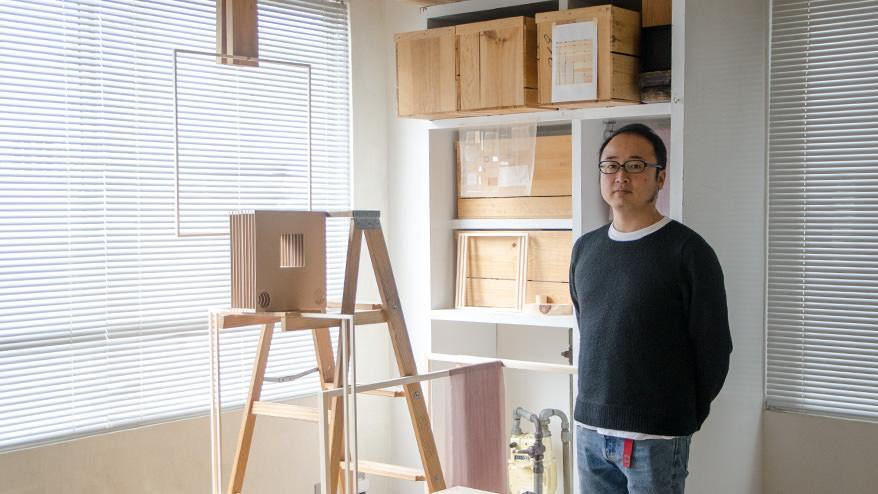This time we will introduce Makoto Yamauchi, a planner in the production department. He is usually seconded to clients' offices and is in charge of the creation, direction, and marketing of various projects. He is rarely at Monosus, but on the days he comes to work, there are always people around him.
He is well-liked for his bright and friendly personality, and he is also the owner of Open Letter , an art gallery that is open only on Sundays.
In this issue of "Two Pairs of Sandals," we will take a look at Yamauchi's past and present.
INDEX
"Communicating" is also "creating."
Open Letter Activities
First, we will introduce the activities at "Open Letter," a gallery he runs that is open only on Sundays.
Open Letter is a commercial gallery* located in Shibuya.
*Commercial galleries are different from rental galleries (art galleries) that only rent out space. Commercial galleries are galleries that contract with artists to exhibit and sell their works. Planning galleries.
It all starts with finding artists that interest you through various media, such as exhibitions, the internet, and magazines.
You contact the artist and say, "I'd like to see your work," and if they say "OK," you're ready to meet them face to face. If you see their work, talk to them, and think, "This is great!" then you can begin negotiations for an exhibition.
Most of the artists featured in Open Letter are in their 20s and 30s and are still unknown.
"Exhibiting in a gallery is a great experience for an artist.
Although my power may be small, I would like to provide such a space and offer support."
Yamauchi says that for him, planning an exhibition is also a form of expressive activity.
"How can we make lesser known artists known? What kind of exhibitions and promotional activities should we do to achieve this?
It’s really fun to think about that together with the writer.”
I also have these thoughts about what I want to do with Open Letter:
"In addition to being an open letter, 'Open Letter' also has the meaning of an open letter of inquiry.
Art shows us that "that's not everything."
I would like to do an exhibition that poses questions and suggestions to the world.
I'm currently in discussions with a certain photographer about an exhibition, and he has lived a very alternative life, and his work reflects that. I'm looking forward to being able to hold the exhibition I've been aiming for."
After talking with the artists and solidifying the contents of the exhibition, we interview them, transcribe them, take photos, and if we have time, create videos, and then compile them all on a landing page.
The page will be posted on the Open Letter website and spread on social media sites such as Facebook .
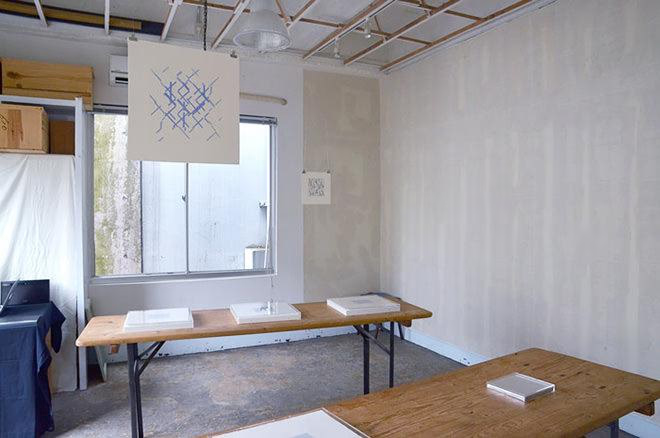
The fourth floor of the Daini Showa Building in Shibuya. This is the Sunday-only gallery "Open Letter." The first exhibition (June 2015)
Customers come to the exhibition one after another.
Some of the people there seem to have come from foreign countries, and Yamauchi even converses with them in English, making use of his experience studying abroad in New York.
What was interesting was that many of the artists who had previously held exhibitions and workshops at Open Letter were also in attendance.
The artists, including Yamauchi, exchanged greetings and chatted with each other.
"Between artists and customers, or among artists.
When I see all kinds of relationships being born here and continuing to exist, I feel glad that I run a gallery!
If possible, I would like it to be that kind of place as much as possible.”

The opening of the three-person exhibition "Memories / Things" held in January 2016
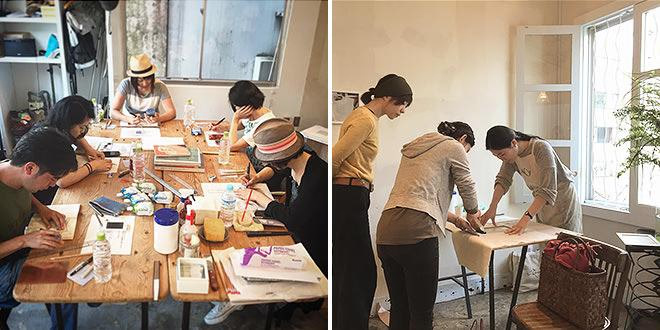
A scene from the "Open Letter Hands-on" workshop. On the left is Emi Hamano's copperplate workshop, and on the right is Nao Nagata's silkscreen workshop. It is also a place where artists and customers can connect with each other.
Since different tenants move in on different days of the week, the exhibited works are removed on the same day. In order to maintain the condition of the exhibits during the exhibition period, careful photographs are taken to record them.
And then again next Sunday morning, we'll work with the artists to create the exhibit.
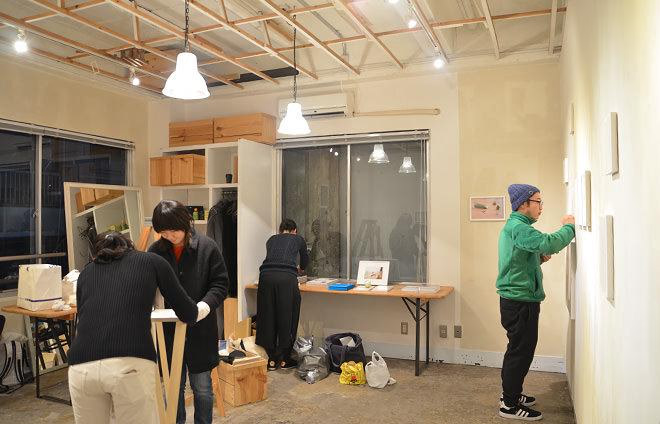
The new exhibits begin being brought in the night before. The final layout of the exhibits is only decided at this time, so everyone stays focused until the last train.
Everything I've done up until now.
What is Makoto Yamauchi's work?
Yamauchi joined the company in January 2011, marking his sixth year here. He joined as a web planner, but at the time he knew nothing about actual web production.
However, at one point, he became so active as a web planner that he was involved in almost all of Monosus' projects, starting with planning.
With Yamauchi joining the planning department, the company began to bring in professional photographers into its production system, thereby raising the creative level, and he has also been involved in launching workshop-style planning, thereby applying the experience he has gained up to that point in time to contribute to strengthening Monosus' creative and planning aspects.
Additionally, three years ago he was seconded to a certain foreign IT company, where he joined the marketing team for the company's products and services.
There we are also involved in web-related creation, direction of movie and still photography, and production of slides to be used at major events.
And then there's Google Innovation Tohoku, which Monosus is helping with.
There, we also worked on creating brochures and videos, as well as planning website production...
Just hearing about the amount of work is enough to make you feel overwhelmed and say, "Wow, that's busy!"
Yamauchi is truly a hard worker. His daily work is already full, and he also does small tasks at the gallery during his breaks and in his free time after returning home. Since the gallery is open on Sundays, he sometimes doesn't even have a day off.
To be honest, I wonder why they went to such lengths.
Why do I wear two pairs of sandals even though my days are so hectic?
To find out, let's take a look back at Yamauchi's career so far.
Encounters with people, places and art.
The story of Makoto Yamauchi
Encounter with street culture
He was born in Ehime Prefecture to a father whose hobby was drawing and a mother who was an art teacher.
I have been close to art since I was a child, so it is natural for me to be exposed to art.
Perhaps influenced by this, he never got bored of drawing pictures using newspaper inserts and the backs of the drawing paper that his father, who worked at a technical high school, would bring home in great numbers.
Yamauchi is a big fan of magazines, and would read the same magazine over and over again, to the point where he had memorized what was written in each section!
It was at this time that he had a fateful encounter while reading Bijutsu Techo (Bijutsu Techo Publishing Co., Ltd.) , a magazine his parents subscribed to.
"When I was in high school, I loved Andy Warhol.
I think that the Velvet Underground and other bands with their original fashion styles are cool, as well as their music activities. They are not only in the art scene, but also in the youth culture scene.
Until then, I had always thought that artists just painted pictures and that was it, but through his work, Warhol created a scene that went beyond the framework of an artist. That's what attracted me."
The art that emerges from this is not just visual, but also has a strong message that incorporates the current social situation.
What art shows us, as Yamauchi said at the beginning.
"That's not everything."
It was street culture such as punk and graffiti that first taught me this.
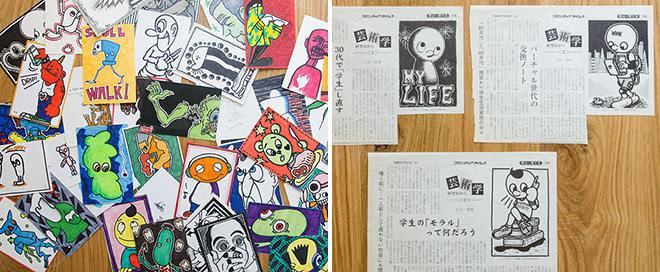
Yamauchi himself has always enjoyed drawing illustrations. When he was a university student, he was given a Copic marker as a gift, which led him to start drawing postcard-sized illustrations (left). A senior graduate student in the same lab was doing illustrations for a serial in a local newspaper in Hokkaido (right).
Daisuke Nishimura, Editor-in-Chief of the Japanese version of TOKION,
And my encounter with the "Home Gallery"
After graduating from high school, I went to university in Hokkaido, a place that had made a lasting impression on me during my junior high school trip. I gained more knowledge of art through being exposed to a variety of music as a member of the light music club and by majoring in aesthetics and art history from my second year. I then went to graduate school in New York, the epicenter of street culture, where I had traveled every year during my time at university.
Her research subject is the relationship between street art and the art world, and her master's thesis was on graffiti writer Barry McGee .
At the same time, I started to immerse myself in New York culture. It was during this time that I met Daisuke Nishimura at the shop of TOKION , a popular culture magazine at the time.
At the time, Nishimura was working on the web for TOKION while also working as a painter and musician. Yamauchi hit it off with Nishimura and decided to visit the art gallery "Cave" where Nishimura lived.
This mysterious space, which was renovated from an auto repair shop and acts as both a gallery and a residence, is home to many young artists working in the fields of art, fashion, music, photography, architecture and more, all of whom continue to work in a DIY style.
Yamauchi said he felt that a new scene was being born here.
Around that time, I heard about it and was intrigued to visit it; it was a gallery that only operated on weekends, and that was set up in a home.
"There's a way to do this too!
It's not all about renting a place and being a full-time employee. I really liked the atmosphere of trying things out within the limits of what we can do."
Free paper "EDUCATED COMMUNITY"
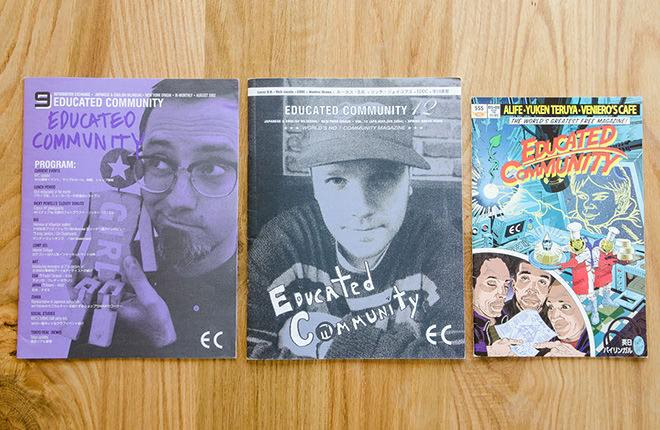
One day, I found this magazine in my locker, and it was a fateful encounter. It's hard to see, but it's written in both English and Japanese. The issue on the far right is the cover of the magazine, which the editor-in-chief suddenly decided to make in an American comic book style, so Yamauchi drew a rough sketch and had an illustrator draw it for him.
Another encounter in New York would change Yamauchi's life.
"EDUCATED COMMUNITY" is a bilingual free paper about street culture.
Yamauchi was so fascinated by the content that he began to participate in editing it himself for about two years while researching and writing his master's thesis.
The members were professional writers and translators, and they participated by making use of their areas of expertise.
However, there are only 3-5 members, all of whom work part-time. They take photos, do the design, make appointments, interview people, write articles, and even distribute the finished free paper themselves! It's completely DIY.
The experience of creating a magazine at EDUCATED COMMUNITY was of great value to Yamauchi later on.
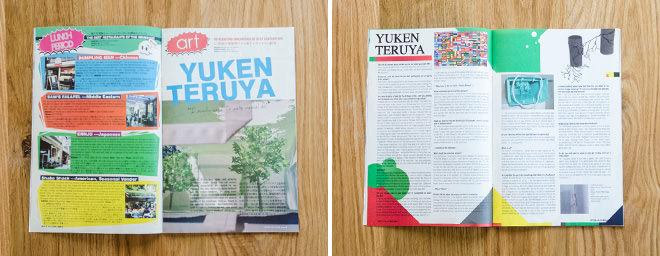
The inside pages of "EDUCATED COMMUNITY." Since they were the ones doing the layout, they learned InDesign on their own.
Returned to Japan.
"Someone's Garden" and "Waiting Room"

Someone's Garden is a free paper that has been published almost every other month since 2007.
I returned to Japan to take a job interview for a magazine company, confident that I would pass. However, I was not selected. After that, I got a job at a company run by the owner of a contemporary art gallery.
"I'm thinking of starting a free paper. Do you want to join in?"
Around that time, a free paper called " Someone's Garden " was started with a suggestion from Daisuke Nishimura, who had returned to Japan before Yamauchi and had become editor-in-chief of the Japanese version of TOKION. The paper introduced the works and activities of artists from Japan and abroad.
However, at that time, Yamauchi was working full-time until after 11pm. After finishing work, he would work until the morning, sleep a little, and then go back to work.
The other members felt the same way, and despite their busy schedules, they found it rewarding to create something from scratch by themselves.
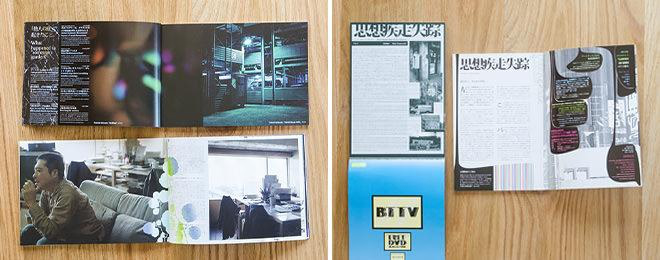
The inside pages of "Someone's Garden." Each member was responsible for the research, writing, and editing.
Yamauchi's interactions with galleries while coordinating art events at "Someone's Garden" have inspired him.
"I want to run my own gallery...
Is there any way to do this immediately?"
At that moment, the scene that I saw in a private gallery in New York came to mind.
"That's it!" Yamauchi thought. He set up a gallery called "Waitingroom" (the name of the gallery is apparently taken from the signature song of " FUGAZI ", a band Yamauchi admires) in a room in his house.
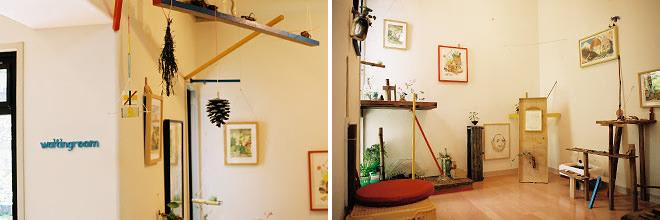
An exhibition scene from "waitingroom" (now located in Ebisu), which began in a room in the apartment in Sangenjaya where the artist lived at the time (an installation by the Argentine artist unit mejunje in 2010).
Put your experience to work professionally.
Joining Monosus and "Open Letter"
Two years before opening Waitingroom, Yamauchi had changed jobs to work at an advertising agency, where he was involved in the editing and production of a member magazine for a certain automobile manufacturer.
You'll accompany big-name photographers on shoots, learning the ins and outs of the job, handling scheduling and appointments, creating magazine layouts with designers, and being present during the submission and printing of copies in the hundreds of thousands.
Even when we take just a reader survey, we have never had the opportunity to think together about how to increase the response rate and how to use the results, or to convert them into numbers.
The experience gained at "EDUCATED COMMUNITY" and "Someone's Garden" will be honed here as a professional job.
After that, I joined Monosus. After a busy schedule, I left Waitingroom and opened Open Letter two years later.
The troubles of being a "two-legged person"
The possibilities of "two-legged sandals"
"To be honest, I have a lot of worries about having to juggle two jobs."
I work at a company during the week and run a gallery that is open only on Sundays.
This is what Yamauchi thinks every time he introduces himself or is introduced to someone else.
"I think for people who are doing art full time, it can sometimes seem like they're not taking risks.
In other words, to put it bluntly, it's just a hobby.
The same goes for artists. I think that most young artists, especially, continue their creative endeavors while working other jobs, but artists who are determined to focus on their creative endeavors no matter what may see them as doing something half-hearted.
In many cases, devoting oneself to one thing, whether it be art or work, is considered an uplifting pursuit.
"In the end, it's a matter of what you want to do and what you value, so it's not a question of what's wrong or who's wrong.
But even so, I still have that kind of complex."
Yamauchi's current activities are a "salad bowl" between his work at Monosus and his activities at Open Letter.
Just the daily work is busier than a full-time job, so gallery tasks often get pushed aside.
"I just don't have the time... Not having time is the lameest excuse... It would be rude to the artists if I couldn't run the gallery properly, but at the same time, I can't neglect my work either... I want to do both properly.
People feel like they "don't have time" when they have a specific list of things they want to do but don't have the time to do them.
That's exactly where we are right now..."
So, are you planning to quit your job one day and focus solely on the gallery?
Yamauchi responded to this question by saying, "I won't quit."
"The biggest reason is that I still don't have the financial confidence or resolve to survive on just one gallery...
Still, there is a lot to gain from the job.
Now I work as a web planner, involved in various creative and marketing projects. I want to utilize the skills and knowledge I have gained there in my work at the gallery."
Galleries are places where the value of art is questioned by the world, but they also function as retail stores.
Artists' works are sold and the proceeds are used to fund activities.
Sales are merely a means to an end, but in these times of economic recession, it is difficult to sell artworks.
“That being said, we have no choice but to rack our brains and come up with some creative solutions.
I want to think of a way to create benefits for both artists and galleries and make the gallery sustainable, even if it is only open once a week. Of course, I don't want to do anything big, just something small, something that can be started on a small scale.
I don't think I would have come up with such an idea if I hadn't had the experience at an advertising production company or Monosus.
Earlier, we talked about some complexes, but on the other hand, I think there are some things you can do because you're 'working'."
For example, if someone wants to open their own gallery, do something different from their current job, something they want to do.
I often hear stories of people suddenly quitting their jobs to pursue that career, but they have to make a living, so it takes a lot of courage...
"Because I work at Monosus, I'm able to run the gallery on Sundays only and provide a venue for young artists to exhibit their work.
It would be great if everyone did this! I think having lots of galleries and spaces like this would help revitalize the scene.
So maybe it's okay to think more positively about having two pairs of shoes.
I believe that there are things I can achieve because of what I am doing now."
If you try to stick to one job, your options may become narrow, but having another job can open up new avenues.
And the skills gained in each can be put to good use in both.
When you think about it that way, wearing two pairs of sandals becomes less scary.
What we can think and do because we are "Nisoku Nowaraji".
Perhaps it is because of this that Yamauchi is able to pursue what he wants to do, despite his busy schedule.
From childhood to college, life in New York, work in Japan, and Open Letter...
Why is Yamauchi, who has walked this path alongside art, so passionate about it?
"Honestly, I don't really have any particular attachment to it. But it's been with me ever since I was old enough to understand, it's influenced me, and it's the thing I'm most attached to. That's why I want to give back in my own way. I think I'm continuing because I haven't been able to do that yet."
Wow, that's so cool!
After saying that, Yamauchi evaded the question by saying, "Well, in the end, I just do it because I love it...!"
Yamauchi's open gallery, "Open Letter," is currently hosting Mari Takemoto's solo exhibition, "Before and Again."
Please come and visit us.
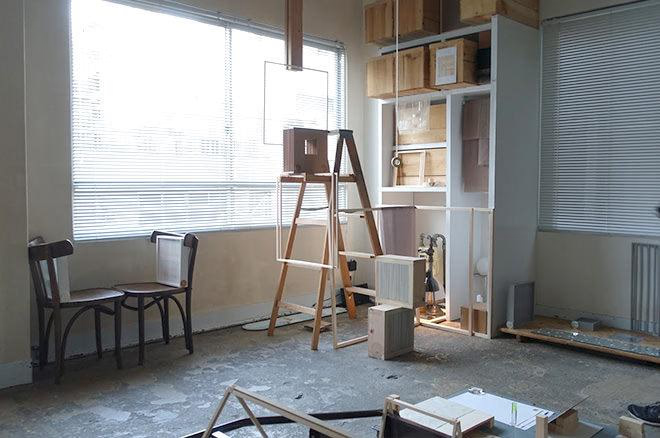
Mari Takemoto "Before and Again"
Date: November 13, 2016 (Sunday) - February 5, 2017 (Sunday)
*Open every Sunday from 12:00 to 19:00 *Closed on November 20th, December 4th, December 25th, and January 1st.
